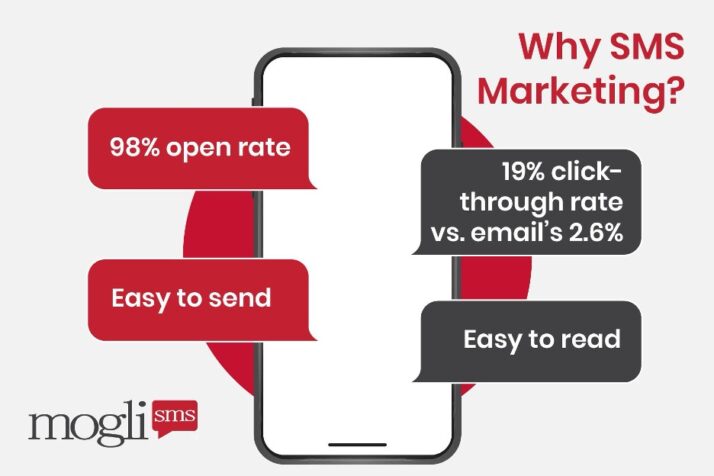How to Enhance a Multichannel Marketing Strategy with Texts

Most nonprofits and educational institutions use a multichannel marketing strategy to engage supporters. After all, some donors may have specific channels they prefer, while others may want to interact with you in as many ways as possible. Email, social media, and direct mail are all nonprofit staples—but don’t stop there.
Text messages present an impactful opportunity to enhance your marketing strategy and connect with supporters quickly and personally.
In this short guide, we’ll explore where texts fit into a holistic multichannel strategy and how they can boost engagement for nonprofits, higher education institutions, and businesses alike. Let’s get started!
1. Understand the strengths of SMS.
Before you incorporate texting into your marketing strategy, you need to understand its strengths as a communication channel and the natural ways it can help you further your marketing and fundraising goals.
Mogli’s SMS marketing guide explains that key strengths of text marketing include its 98% open rate, average 19% click-through rate (CTR), and how easy it is to both send and receive messages. This means that recipients are much more likely to open and read your texts than emails (and to do so quickly).

These strengths make text messages especially well-suited for:
- Relationship-building efforts. The ease and fast pace of texting naturally encourage two-way communication, inviting students, prospects, and donors to engage in conversations that build relationships.
- Reminders, check-ins, and updates. Texts can be your go-to channel for any quick message you need to share with both individuals and large groups since recipients are likely to read them and respond quickly.
- Answering questions. If supporters or students have questions about an event, fundraiser, application, or anything else, they can easily ask and receive an answer via text. Be sure to respond to questions promptly and open the door to larger conversations that help you strengthen supporter relationships.
- Urgent fundraising appeals. Whether it’s GivingTuesday or the final day of a major fundraising campaign, texts are one of the best ways to spread the word about urgent calls for donations and attract attention to your time-sensitive campaign.
These use cases are just the beginning. Depending on your unique marketing and fundraising goals, you might also use texts to thank donors, request feedback, promote events, share links to your website or social media, and more.
2. Look for gaps in your current multichannel strategy.
Now that you understand potential uses for text marketing, take a look at your current multichannel strategy. Evaluate the channels you use, what you use them for, and each channel’s performance. As you explore your data, ask yourself questions like:
- Where are you missing opportunities?
- Which types of messages get lower response rates or CTRs on certain channels?
- What types of messages don’t get enough engagement?
- What are your priorities for improvement?
- Which messages do you need to share more urgently?
- How do supporters typically engage with each channel?
Based on your answers, identify gaps in your strategy and how you could fill them in with text messages. Think about the opportunities and improvement areas you found and whether the strengths of SMS might help you address them.
For example, say that one of your priorities is to improve the overall donor journey. You notice that your first donor welcome email gets plenty of engagement, but new donors start dropping off quickly and often don’t engage with additional fundraising appeals and event invitations. You realize you need to put more effort into relationship building early on—and texts can help.
To update your strategy, you might create a series of text messages that introduce donors to different aspects of your organization in small bites and encourage responses. You could even set up this string of texts to begin automatically after you send the first welcome email.
3. Create initial SMS marketing content.
Next, draft a few text messages that serve the purposes you outlined in the last step and incorporate them into your multichannel marketing plan. These texts should serve as a good starting point and be easy to tailor to specific audiences and needs.
Consider creating different text marketing content for various supporter segments and occasions. For instance, you might develop a new donor welcome series of texts along with several donor appreciation messages geared toward donors at different giving levels.
4. Update your text marketing strategy as needed.
Once you’ve determined the best ways to incorporate SMS into your marketing strategy and created your initial content, start implementing your new approach. As you do so, monitor the performance of your enhanced strategy by keeping tabs on key metrics like:
- Per-channel conversion rates: If your goal is to get recipients to donate through your online donation form, a conversion would be a recipient who completes an online donation. Compare conversion rates across channels to see which channels best inspire giving or other actions like signing up for events.
- Text message CTR and response rates: Monitor the percentage of recipients who click on links in your texts or respond to them to better understand how compelling your content is.
- SMS opt-out rates: Some recipients are bound to opt out of texts due to personal preferences. However, a high SMS opt-out rate could point to a disconnect between your text marketing strategy and your donors. Investigate which messages or campaigns led supporters to opt out and adjust your strategy accordingly.
In addition to these metrics, choose key performance indicators (KPIs) based on your unique goals. If your goal for enhancing your overall marketing strategy is to acquire more donors, for instance, your KPIs should also include metrics like donor acquisition rate, cost to acquire, etc.
Text messages can be an impactful addition to any multichannel marketing strategy, but their effectiveness will ultimately depend on your content and its relevance to your audience. Stay open to feedback and continue to adjust your strategy based on results, and you’ll be able to send texts that engage and inspire supporters long-term.
